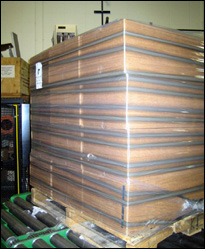Pliant, a $2 billion manufacturer of packaging products, says it has developed an RFID-enabled stretch film. The company claims its customers—which include the U.S. Department of Defense (DOD), as well as pharmaceutical and consumer packaged goods companies—could use the product not only to comply with government or retail RFID mandates, but also to determine whether individual pallets have been tampered with.
Stretch film, also known as stretch wrap, is a clear polyethylene film that clings to itself and typically is used to bind a number of small, individual cases together to create a larger unified load, such as a pallet. Pliant has worked with nanoparticle materials company NovaCentrix to devise a means of printing an electrically conductive trace into its stretch film using NovaCentrix’s silver ink. The conductive trace is printed in two parallel lines, 6 inches apart and 1 to 1.5 inches wide.
Once the film is wrapped a number of times around the goods on the pallet, a battery-powered circuit board, electrically connected to a passive EPC Gen 2 tag, is attached to the end points of the conductive trace with a conductive adhesive. The tag is modified such that it is only readable when the circuit—made complete when the circuit board and tag are attached to the film’s end points—is whole.
At the point of receipt of a shipped pallet, a user can attempt to read the tag using a standard Gen 2 reader. If the stretch film has been cut across any of the circuit trace, thereby breaking the circuit, the tagcannot be read. Moreover, if the conductive trace has been stretched to the point that its electrical resistance exceeds a predetermined level—set by the user and measured by the circuitry—the Gen 2 passive tag is no longer readable. When the pallet is broken down, the circuit board and batteries are removed and the pallet can then be reused.
An unreadable tag is indicative of possible tampering with the contents of the pallet, and the end user would divert the pallet for inspection. To identify the pallet in situations when the stretch film’s tag no longer functions, Pliant’s system calls for the application of a secondary, standard Gen 2 smart label, encoded with an EPC containing the same product information as the tag linked to the circuit. The two EPCs are stored in a database and linked together, indicating that they both are attached to the same pallet.
Doug Lilac, Pliant’s technical director for innovation, says the company worked with a number of technology providers to develop the new product platform, currently being demonstrated at two of its research and development centers in Newport News, Va., and Chippewa Falls, Wisc. Pliant has not yet settled on a name for the platform, and says it is continuing to optimize the system, which is being pilot-tested at the R&D centers. However, Bill Barlow, a product development engineer with Pliant, says the company is ready to begin working with its customers that want to begin testing the product in their own facilities. Pliant declined to reveal any pricing information for the platform at this stage.
Lilac says Pliant can modify any EPC Gen 2 standard inlay to work with the circuit board. Both it and the secondary tag can be used to satisfy RFID mandate requirements from Wal-Mart, Target and other retailers. According to Lilac, Pliant has been working with the DOD since the earliest stages of its RFID product development, and the government department is currently working with Pliant to test the system for such DOD applications as transporting pallets of high-value or hazardous materials between DOD depots, as well as relying on the system to indicate possible tampering with the pallet.
Pliant, Lilac notes, believes its customers in the pharmaceutical industry would also be interested in using the RFID-enabled film to bolster its product security measures—while also using it to track pallets. Pliant chose to create a tamper-evident stretch film based on RFID technology not only because of the cross-functionality it offers with product tracking, but also because it can cut labor costs. Because it can indicate a tampering event without requiring a physical inspection via a line-of-sight laser scanner, such as those required by some specialized inks, RFID adds a level of time and labor efficiencies. “If you have pallets stacked three high and three deep, you can’t see the ones in back,” says Bill Barlow, product development engineer for Pliant, “so something like an ink-based technology [for indicating tampering] would not be as easy to check as RFID.”
IBM assisted Pliant in deploying proof-of-concept demonstrations of the system at its Virginia and Wisconsin R&D centers. Pallets are built and wrapped in the RFID-enabled film at each center, then sent to the opposite center, where Pliant staff members use handheld interrogators running IBM’s WebSphere RFID middleware to read the tags attached to the pallets. IBM consultants worked with Pliant to create Web pages on a network database, allowing them to collect the tag data and read events and locations from the WebSphere middleware.
Pliant customers looking to use the RFID-enabled stretch film could choose either WebSphere or other RFID middleware platforms to manage the tag data, says Lilac. The middleware would need to associate the pallet, however, with the EPCs of both the tag linked to the conductive trace and the one embedded in the secondary label.


